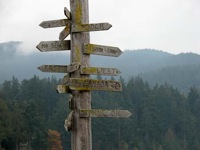Difference between revisions of "Direction"
m (Text replacement - "http://" to "https://") |
|||
| (One intermediate revision by the same user not shown) | |||
| Line 3: | Line 3: | ||
==Origin== | ==Origin== | ||
Latin ''dīrectiōn-em'' , n. of [[action]] from ''dīrig-ĕre'' to direct | Latin ''dīrectiōn-em'' , n. of [[action]] from ''dīrig-ĕre'' to direct | ||
| − | *[ | + | *[https://en.wikipedia.org/wiki/15th_century 15th Century] |
==Definitions== | ==Definitions== | ||
*1: [[guidance]] or supervision of [[action]] or conduct : [[management]] | *1: [[guidance]] or supervision of [[action]] or conduct : [[management]] | ||
| Line 19: | Line 19: | ||
---- | ---- | ||
| − | <center>For lessons on the related [[topic]] of '''''[[Guidance]]''''', follow [ | + | <center>For lessons on the related [[topic]] of '''''[[Guidance]]''''', follow [https://nordan.daynal.org/wiki/index.php?title=Category:Guidance '''''this link'''''].</center> |
==Description== | ==Description== | ||
| − | '''Direction''' is the [[information]] contained in the [[relative]] position of one [[point]] with respect to another point without the distance [[information]]. Directions may be either [[relative]] to some indicated [[reference]] (the violins in a full [[orchestra]] are typically seated to the left of the conductor), or [[absolute]] according to some previously agreed upon [[frame of reference]] (New York City lies due west of Madrid). Direction is often indicated manually by an extended index finger or [[written]] as an arrow. On a vertically oriented sign representing a [[horizontal]] [[plane]], such as a road sign, "forward" is usually indicated by an upward arrow. [[Mathematically]], direction may be [[uniquely]] specified by a [ | + | '''Direction''' is the [[information]] contained in the [[relative]] position of one [[point]] with respect to another point without the distance [[information]]. Directions may be either [[relative]] to some indicated [[reference]] (the violins in a full [[orchestra]] are typically seated to the left of the conductor), or [[absolute]] according to some previously agreed upon [[frame of reference]] (New York City lies due west of Madrid). Direction is often indicated manually by an extended index finger or [[written]] as an arrow. On a vertically oriented sign representing a [[horizontal]] [[plane]], such as a road sign, "forward" is usually indicated by an upward arrow. [[Mathematically]], direction may be [[uniquely]] specified by a [https://en.wikipedia.org/wiki/Unit_vector unit vector] in a given basis, or equivalently by the angles made by the most direct path with respect to a specified set of axes. |
[[Category: Mathematics]] | [[Category: Mathematics]] | ||
[[Category: General Reference]] | [[Category: General Reference]] | ||
Latest revision as of 00:05, 13 December 2020
Origin
Latin dīrectiōn-em , n. of action from dīrig-ĕre to direct
Definitions
- 1: guidance or supervision of action or conduct : management
- 2. archaic : superscription
- 3a : an explicit instruction : order
- b : assistance in pointing out the proper route —usually used in plural <asked for directions to the beach>
- 4: the line or course on which something is moving or is aimed to move or along which something is pointing or facing
- 5. archaic : directorate
- 6a : a channel or direct course of thought or action
- b : tendency, trend
- c : a guiding, governing, or motivating purpose
- b : a word, phrase, or sign indicating the appropriate tempo, mood, or intensity of a passage or movement in music
Description
Direction is the information contained in the relative position of one point with respect to another point without the distance information. Directions may be either relative to some indicated reference (the violins in a full orchestra are typically seated to the left of the conductor), or absolute according to some previously agreed upon frame of reference (New York City lies due west of Madrid). Direction is often indicated manually by an extended index finger or written as an arrow. On a vertically oriented sign representing a horizontal plane, such as a road sign, "forward" is usually indicated by an upward arrow. Mathematically, direction may be uniquely specified by a unit vector in a given basis, or equivalently by the angles made by the most direct path with respect to a specified set of axes.
